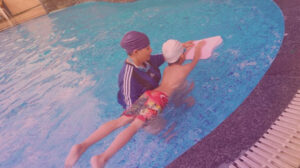IS IT REALY ONLY A KNEE PAIN OR MENISCUS INJURY
A meniscus tear is a common knee injury. Meniscus injuries which block normal knee motion, causing persistent pain and functional limitations, are often best managed with knee rehabilitation. A tear is usually caused by twisting or turning quickly, often with the foot planted while the knee is bent. The meniscus is a rubbery, C-shaped disc that cushions your knee. Meniscus tears can occur when you lift something heavy or play sports. As you get older, your meniscus gets worn. This can make it tear more easily. Certain tears can be quite inconsequential. Physical therapy is very useful in helping you regain the full range of motion in your knee joint. If you are an athlete who needs to be out on the field quickly, surgery may be the first step. For many people, however, physical therapy is a more conservative and less invasive treatment that can have good outcomes, especially if you are older or have osteoarthritis.
Even major tears that are found on MRI do not necessarily require surgery. In these cases, you may have an episode of swelling, pain and even locking that with treatment resolve within the duration of 2 to 3 months. According to many studies, all tears should be treated first with physiotherapy and often, with treatment aimed at reducing swelling, inflammation and increasing ROM and functional strength, your knee can function normally. Then the result of treatment (rehabilitation) over time is one of the best indicators of the necessity for surgery. If the swelling and or pain persists or if the pain and swelling return again once rehab has finished, then it is likely that surgery will be required. .
How is a meniscus tear treated?
How your doctor treats your meniscus tear depends on several things, such as the type of tear, where it is, and how serious it is. Your age and how active you are may also affect your treatment choices. Ordinarily, you’ll be asked to reduce your sports activities while your meniscus tear heals. This could take about 4 – 8 weeks. However, the time depends on the severity and position of the tear. During this period, you should do strength training to strengthen your core and glutei muscles. This enables you to have better control of your femur while you run. Initial non-surgical or “conservative” treatments focus on reducing the pain and swelling that accompanies a meniscus tear. Icing the joint and taking an anti-inflammatory drug such as aspirin, acetaminophen (Tylenol), or ibuprofen can help with this. Rest your leg as much as you can, and periodically prop it up with a couple of pillows to further reduce swelling. If the pain is bad enough, you may need to walk with crutches until you can place more weight on your leg. Then gradually with physiotherapy your pain will reduce and you will gain strength in knee.
Treatment may include:
Rest, ice, wrapping the knee with an elastic bandage, and propping up the leg on pillows
Physical therapy – modalities and exercise
Surgery to repair the meniscus
Surgery to remove part of the meniscus
The Goal of Physical Therapy
The goal of physical therapy for a meniscus tear is to rebuild your strength and range of motion in the knee. These exercises can also help prevent future injuries by strengthening the muscles that support the joint. The areas of focus for physical therapy include the quads and hamstrings as well as your calves. Your physical therapist and doctor will develop a plan that most likely will emphasize regaining range of motion first and in the beginning, you may do nothing more than stretch until you can do so without pain. As your tolerance and strength grow, more aggressive exercises can be added to your regimen, including squats and leg raises. Together with a home exercise program, is often beneficial in facilitating your return to the court.
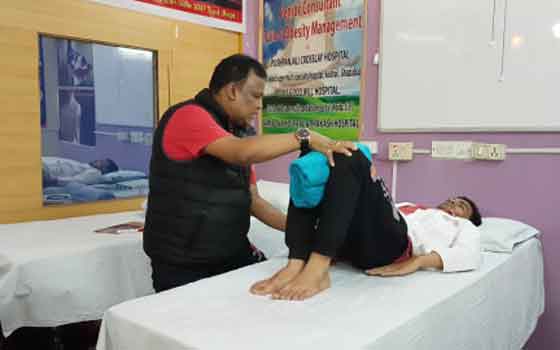
The following are common exercises that help with rehabilitation for both non-operative meniscus tears as well as following menisci surgery. Start with the first 3 and move on to the second 3 when the pain has ceased.
1) Hamstring Stretch: While lying on your back with your buttock close to a doorway, place your injured leg up on the wall. Slowly move your buttock closer to the wall. You will feel the stretch of the hamstring increase. Move to a comfortable stretch and hold for 30-60 seconds. Repeat 3 times.
2) Straight Leg Raise:
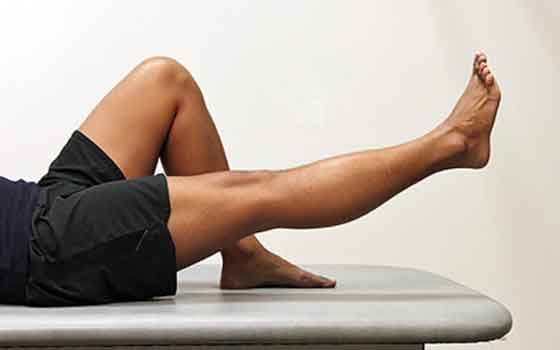
Sit on the floor with your uninjured leg bent and your injured leg straight. Press the back of your injured leg down, tightening the top part of your thigh (the quadriceps muscle). It is usually helpful to raise your toes toward your knee. Raise your leg about 6-8 inches from the ground and hold for 10-20 seconds. Repeat this 20 times. You can focus on different parts of your thigh by rotating your toes in or out.
3. Calf Stretch: Face a wall and place your hands against the wall at shoulder level. Place your injured leg back and your uninjured leg forward. The uninjured leg should be slightly flexed and the injured leg should be straight with your foot flat on the ground. As you lean forward, you should feel the calf muscle stretch. Hold for 30 seconds. Repeat 5-10 times.
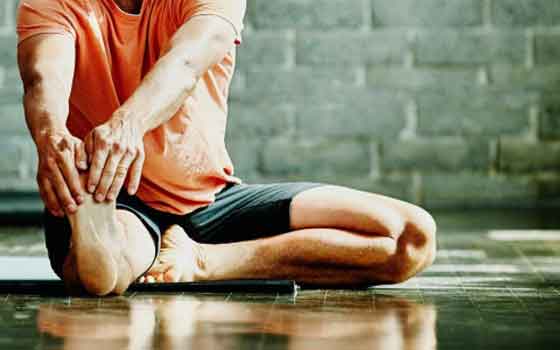
4. Heel Slide: While sitting on the floor, slowly slide the heel of your injured knee toward your buttock, pulling your uninjured knee toward your chest. Return your leg to the extended position. Repeat 20 times.
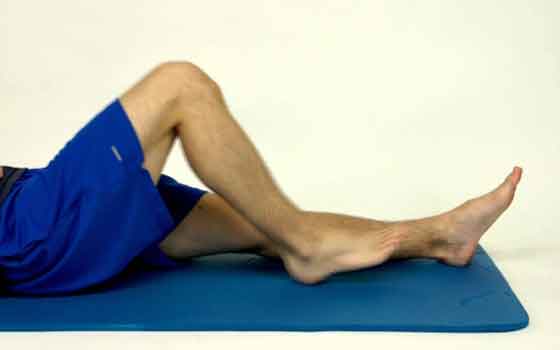
5. Step-Ups: Stand with your injured leg on a block that is 3-5 inches high. Keep the foot of your uninjured leg flat on the floor. Shift your weight to the injured leg and straighten, lifting the uninjured leg off the floor. Return the uninjured leg to the floor. Repeat 10-20 times.
6. Wall Squat: Stand with your back up against the wall. Keep your feet shoulder width apart and your feet 1-2 feet from the wall. Place a rolled-up towel or pillow between your legs. Squat down until your thighs are parallel to the floor. Hold for 20 seconds and slowly stand up. Keep the pillow or towel squeezed between your legs. Repeat 10-20 times.
7. Isoquards exercise: in lying position straight your legs and place a roll of towel under you knee and try to press it with stretch your foot hold it for 10 sec and do 10-15 reps and at a time do on one leg after that on other one.
Dynamic quards exercise in sitting position.
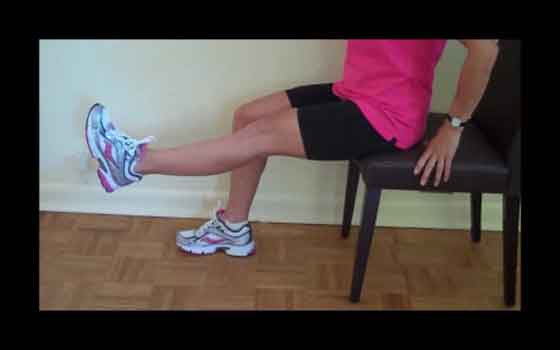
8. Isohams exercise: in laying position bend your one leg around 30-40 degrees and try to press the couch with your heel hold it for 10 sec and do10-15 reps in each leg.
REHABILITATE YOUR KNEE WITH BEST PHYSIOTHERAPIST IN DHKOLI…
Blossom physiotherapy and rehabilitation center is leading physiotherapy center these days in dhkoli. They provide ultra modular facilities in affordable price with the team of experienced and well known doctor. Dr.Jyoti Gupta Gupta (MPT pediatrics) that is a Pediatrics Physiotherapist as well as a certified Yoga instructor she complete her course from a well known YOGA ALLIANCE INTER NATIONAL FnY STUDIO is a head of the center and senior physiotherapist. She applies her precious knowledge in treating patients and always come with visible outcome.
As the knee joint is very important joint of our body because it carries our whole body weight. Some time when we feel any jerk or suddenly our knee gets twisted we fell pain and think it will vanish after some time but it become adverse with time and ultimately doctor will tell about the surgery. Better is to always consult immediately with expert physiotherapy doctor so that they will starts rehabilitate your knee as soon as possible. And save you from painful surgeries. We now know that the majority of patients have at least as good outcomes (reduction of pain and improved function) if they perform a physiotherapist supervised exercise rehabilitation program for a few months instead of having surgery. Not all physiotherapy is the same and it is important that the physiotherapist that guides your rehab performs a thorough examination of your knees, understands your specific needs and tailors your exercise program accordingly. In some cases, the pain in the knee is too severe to perform the rehab exercises or too swollen to allow the muscles around the knee to work effectively. In these circumstances, treatment with either anti-inflammatory tablets (guided by a doctor) or an injection into the knee are recommended. These treatments can settle your pain and swelling sufficiently to allow you to perform rehabilitation work.
Although the majority of patients will not need surgery for their meniscus injury, some people will still have pain after performing rehab. When this is the case, surgery for the meniscus should be considered. But after surgery rehabilitation become most important for returning to your daily activities. So it’s better to initially go for rehabilitate.
Blossom physiotherapy center having ultra modular modalities which help in reduction of pain without use of medicine. And Dr Jyoti set your rehab protocol according to your injury which will help you to overcome with the situation in healthier manner. So in nut shell I want to tell that you must visit in clinic and experience the results by your own self. For further information log into blossomphysitherapy.


